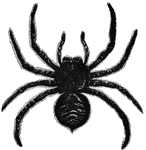Clipart tagged: ‘articula’

Mason Bee
"The Mason Bee, Osmia, of which there are many kinds, makes its cells in spaces from which…

Nest of the Carder Bee
"The elevation of the dome, which is all built from the interior, is from four to six inches above the…

Turnip Fly
The European Turnip-Fly, Haltica nemorum, one of the most destructive species, belongs to a…

Digestive Apparatus of an Insect
"a, head, antennae, &c; b, pharynx; c, crop; d, gizzard; e, chyle-forming stomach; f, biliary vessels;…

Tarantula
"The most celebrated of the Lycosidae is the Tarantula, Lycosa tarantula, of Southern Europe,…